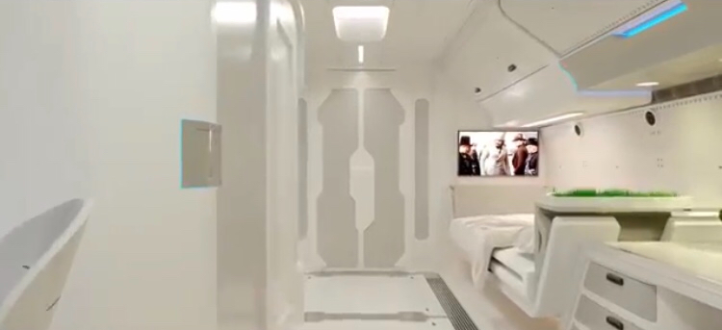
On June 21, the scientific and technical conference for non-rocket near space industrialization was held in Belarus. It was attended by inventors, representatives of academic and scientific circles, public organizations from Belarus and foreign countries, including the UK, Germany, Peru, India, United Arab Emirates, Moldova, Russia, Ukraine, Latvia, Slovakia and Estonia. The first conference dedicated to the issues of space-free industrialization of space was held in 1988 and gathered about 500 guests from the USSR and abroad. After 30 years, this issue is even more relevant.

How the Transportation of the Future Works
At the same time, the basic principles of GPV operation are quite simple. Anatoly Unitsky formulated them in 1982 in his article “Interchange, Space, Ring” published in the journal “Inventor and Innovator”. The ideal transport would be one that uses only internal forces, says the inventor. That is why, it must have the shape of a ring.
Thus, the General Planetary Vehicle is a geocosmic aircraft covering the planet in the equatorial plane. The peculiarity of GPV functioning is that going into space is carried out by increasing the diameter of its ring and achieving at the design altitude (with passengers and cargo) the peripheral velocity of the body equal to the first cosmic velocity. At the same time, the position of the center of mass of GPV does not change in the process of going into space – it always coincides with the center of mass of the planet.
The optimal internal driving force for GPV is excessive centrifugal force from a belt flywheel accelerated around the planet in a vacuum channel using a linear electric motor and a magnetic cushion to speeds exceeding the first cosmic one – up to 10–12 km/s, depending on the ratio of the linear masses of the body and the flywheel.
This is not very high speed: it is thousands of times lower, for example, than the speed approaching 300,000 km/s, obtained on the same principles in modern charge particle accelerators. For the transfer of momentum and moment of momentum to the body of GPV when entering the orbit in order to obtain an orbital speed equal to the first cosmic velocity, a second belt flywheel is required, also covering the planet.

The Organization of Work and Living in the Orbit
In the Earth’s industry, including transport, energy, communications and information technology, about 1 billion employees work today. Perhaps in the future, this need will drop a thousand times, to a million employees. The number of tourists and vacationers will not descrease, as in space you can create recreational complexes with better conditions than on Earth.
Therefore, in orbit it will be necessary to create residential settlements of a new type – EcoCosmoHouses, in which millions of people will live, work, relax, take courses of therapy and treatment.
In such a house for several thousand inhabitants – in a small society of a village type created on innovative principles – the best part of the Earth’s biosphere will be recreated with all the necessary environmental conditions: atmosphere, landscapes diversity, living organisms, soils, biogeocenoses, aquatic ecosystems, etc.
The most comfortable physical conditions will also be created: gravity, illumination in the natural spectrum, optimum temperature, pressure and air humidity.

The cross-size of these structures is up to 500 m in order not to excessively increase their wind resistance, which would slow down the entire industrial complex due to the presence of a gaseous environment at this altitude, although very rarefied – for example, at 400 km, the atmosphere can only be spoken figuratively, since its density is very low – almost a trillion times lower than at atmospheric pressure.
For a comfortable living in space, people need conditions that are equivalent and even surpass the Earth’s ones in quality.
Gravity in orbit will be created by centrifugal forces. Reduced gravity will be the most comfortable, similar to that on the Moon or Mars, with an acceleration of free fall of about 2 m/s2, that is five times lower than on Earth. Then an adult would weigh about 15 kg and could fly like a bird if being provided with wings.
In the cosmic house, both day and year lose their meaning, as it will make one revolution around the planet in about 1.5 hours – 16 times during the day, going through sunrises and sunsets. Therefore, in the orbital house, artificial lighting should be, and the day and year may have an optimal duration that differs, respectively, from 24 hours and 365 days. For example, for most modern city dwellers, 24-hour period is imposed and forced, as evidenced by the regular use of the alarm clock.
Comfortable lighting is necessary in the house for people, plants and animals. In this case, the light should be:
– qualitative – by spectrum,
– long, since most plants are gaining strength and bloom only when the light day is at least 14 hours,
– intense, as poor lighting for plants is fatal.
The perfect choice for light-demanding species – the illumination of 100,000 lux, like that of sunlight. In any case, the source of illumination in the cosmic house should be the Sun – either with the help of special mirrors and lenses, or by converting sunlight into electrical energy.

In the cosmic house, the biosphere of the planet should be completely simulated. It is necessary to present the flora and fauna of the subtropics in all its diversity — the Earth’s most favorable climatic zones, primarily the microflora and microfauna, which is the soil biogeocenosis with thousands of microorganism species.
Healthy (living) fertile soil in EcoCosmoHouse – the basis of comfortable and safe conditions for human habitation. The beginning of the human immune system is in the soil – the microflora and microfauna of our intestines, which is mainly considered soilborne.
There live trillions of microorganisms of thousands of species. They work day and night – they feed, water and even … treat us. Not for nothing, many experts call the intestinal contents our second brain. The biosphere of the cosmic house must constantly produce the oxygen necessary for breathing of people and animals living there, produce healthy food and dispose all the waste products of living organisms, including human ones, into the humus.
The existing orbital stations do not fully protect against are meteoric and radiation hazards existing both in space and Earth orbit. For example, a drop of water at a speed of 20 km/s is able to drill a hole in a tank armor, and space radiation can kill a person in a few days, since its level is much higher than at the Chernobyl nuclear power plant.
The most effective protection against these two main cosmic dangers are not heavy-duty thin-walled screens, but thick multi-layered barriers, which can be a multimeter layer of soil inside of the cosmic ecohouse, as well as water – groundwater and in water reservoirs.
The constructive part of the cosmic residential cluster will be a hollow sphere, or a cylinder, or a torus, or combinations thereof, rotating around its axis. For the initial spinup of a quite massive space settlements weighing about a million tons, they can be made paired, placed on the same axis – either next to each other, or placed in each other according to the Matryoshka doll principle. Then you can get any peripheral speed, and accordingly – gravity, using an electric motor, and not a jet engine, with one part rotating in one direction, and the other part – in the opposite one.
The most material-intensive part of the house will be anti-meteoritic and anti-radiation protection, as well as a layer of soil – their total thickness can reach ten meters.
The house will create ecosystems of reservoirs with fresh and sea water, a light breeze will blow, there will be clouds and occasionally warm rain will fall. The sloping part of the soil, closer to the axis of rotation, will be completed with mountain landscapes, streams, waterfalls and relevant ecosystems.
The air in the cosmic house will be filled with smells of flowers and useful phytoncides, the favorable effect of which on the human body cannot be compared with any medicament. Noise will absent, there’ll be only the singing of birds and the rustle of trees.

The estimated weight of materials required for the construction of a cosmic house for 5 thousand people in orbit will be about 500 thousand tons, including:
– structural shell– 2 thous. tons;
– anti-radiation and anti-meteorite protection – 100 thous. tons;
– fertile living soil (ecochernozem) – 200 thous. tons;
– water (fresh and sea) – 100 thous. tons;
– air – 10 thous. tons;
– construction materials and structures, including those for dwellings inside the cosmic house – 50 thous. tons;
– other – 38 thous. tons.
The delivery of all materials for one EcoCosmoHouse with GPV to the orbit will cost about 500 million USD. Materials for it, including water and soil, will also cost about 500 million USD, construction and installation work will cost about 1 billion USD.
Thus, the extra-terrestrial colony in orbit, in which several thousand ordinary people can live and work, will cost about 2 billion USD. This, for example, is 75 times cheaper than the International Space Station, whose value has already exceeded $150 billion, although no more than 10 specially trained astronauts can live and work at the same time.
If such a single space house can be built today with the help of rockets, then it will take 500 years and 5 trillion USD to deliver materials from the Earth to orbit. GPV, in one flight, will be able to deliver materials and equipment for the simultaneous construction of 10 such EcoCosmoHouses.
Virtually all engineering solutions used in the proposed SpaceWay project are widely known, tested in practice and currently implemented in industry. The project budget will be about 2.5 trillion USD. This is not so much, given that the annual military budget of the United States today is almost 700 billion USD.
At the same time, the technological basis for the construction of the launch overpass will be SkyWay systems, which will make it possible to make a profit from the project at the initial stages of its implementation by transporting passengers and cargo on the surface of the planet.
Source: rsw-systems.com

सोचो वैश्विक स्तर पर * 放眼全球 * THINK GLOBAL * 思う グローバル * فكر عالميا
Business Development – Innovations & Future Technology – Investment
https://intercontact.wordpress.com



Business Development – Innovations & Future Technology – Investment


UNICEF $50-100K Funding Opportunity for Blockchain Start-ups


REQUESTS FOR PROPOSALS | AI for Earth Innovation | National Geographic Society


Toyota AI Ventures Launch New $100M Fund


Solar Energy in Industrial Processes | EU Call for Proposals


EU Call for Proposals | Digital Information Management


Business and Investment Opportunities in EU


Turning the tide on climate change – Enel Open Innovability


European Pre-Commercial Procurement Programme for Wave Energy Research & Development


The OCEARCH an collaborative, inclusive and open-sourced project to geared to helping scientists collect previously unattainable data on animal movements from deep in the world’s oceans.
Track sharks, whales, turtles, seals, dolphins, alligators

¡Muchas gracias a todos y respeto!


再見 * Goodbye * Adiós * Au revoir * Adeus * Auf Wiedersehen * До свидания * Arrivederci * さようなら * Güle güle * Selamat tinggal * नमस्ते * Totsiens * Αντίο * معالسلامة * Tot ziens * Adiaŭ * Kwaheri * Do widzenia * Viszontlátásra *